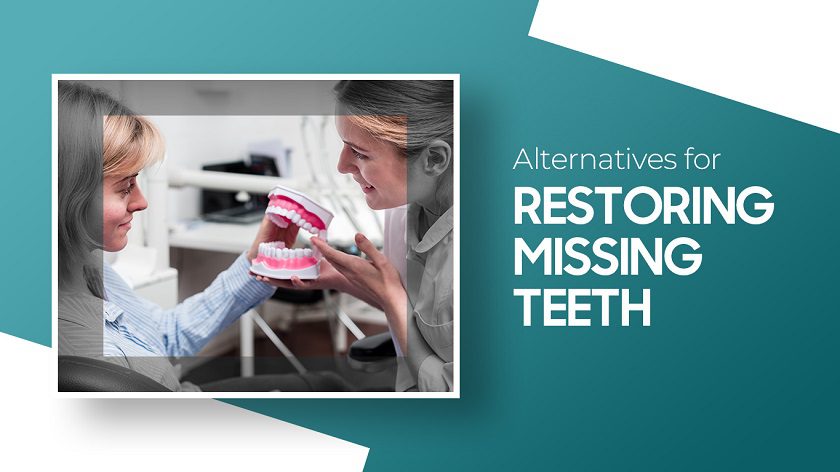Losing one or more permanent teeth due to decay, injury, or gum disease is very common. Missing teeth affect your smile and your ability to chew, speak, and maintain proper oral health. Thankfully, modern dentistry offers several effective ways to restore tooth loss. The right solution for you depends on many factors, like the location of the gap, the number of missing teeth, and your personal preferences. This article discusses some alternatives for restoring missing teeth.
Dental Implants
Many dentists consider Dental implants the optimal choice to replace missing teeth. A small titanium screw is surgically embedded in the jawbone, which fuses with the bone over time. This provides a stable anchor for crowns, bridges, and dentures. Implants help preserve natural bone and prevent sagging facial muscles. They allow comfortable biting and chewing with full force. The success rate is also very high – over 95% of implants survive for over ten years.
Dental Bridges
Dental bridges span the gap created by one or more missing teeth. A bridge comprises artificial teeth supported by crowns cemented onto the natural teeth on either side. Traditional bridges have crowns and pontics made of porcelain fused to a metal alloy. Newer options use all ceramic materials for better aesthetics. Bridges can restore a smile with minimal gaps and enable proper chewing function. However, adjacent teeth are altered for crowns to attach to the bridge.
Partial and Full Dentures
Removable partial or full dentures are simple and budget-friendly options to replace multiple lost teeth. Partial dentures use metal clasps to attach to remaining teeth, while full dentures rest on the gums and are held by suction. Dentures can initially feel uncomfortable, but you get used to them with time. However, they do not feel as natural or stable as fixed solutions. Dentures need to be removed daily for cleaning – the risk of bone loss and gum issues is higher.
Flap Surgery with Bone Grafting
This procedure is done when missing teeth cause significant bone loss in the area. Bone from other sites like the chin, or synthetic bone, is grafted after flap surgery to build up the ridge. It provides an adequate foundation for implants or fixed bridges later. Recovery takes several months and requires meticulous post-op oral care. The grafted bone integrates with natural bone over time.
Non-Implant Fixed Bridges
Traditional bridges are a cost-effective way to replace one or two adjacent missing teeth when implants are not possible. Preparing the neighbouring teeth for crowns helps anchor the bridge firmly. The artificial teeth, called pontics, are fused between crown abutments for a natural appearance and function. Careful oral hygiene is needed to prevent decay and gum disease around the bridge.
Removable Partial Dentures
Partial dentures with acrylic artificial teeth can replace multiple lost teeth on the same dental arch. Chrome clasps hold the denture in place but are less noticeable than full denture plates. Partial dentures can be made quickly and inexpensively. However, they are not very stable or retentive compared to fixed options. Frequent adjustments may be needed as mouth tissues change.
Dental Braces
Braces slowly close gaps by moving neighbouring teeth using gentle pressure. This orthodontic method works best for teens losing deciduous teeth. But adult braces are also possible. Special clear or lingual braces are more discrete. The process takes several months and requires very dedicated oral hygiene. Braces are cost-effective but cannot replace multiple lost teeth.
Maryland Bridges
This fixed option uses a prosthetic tooth with metal wings bonded to the back of adjacent natural teeth. Unlike traditional bridges, Maryland bridges don’t require crowning healthy teeth. But they are less retentive and can only replace one missing tooth with natural teeth on both sides. Careful bonding and oral hygiene are musts for longevity.
Implant-Supported Dentures
Combining implants with removable dentures provides stability while preserving bone. Implants bear chewing forces rather than the gums. Lower dentures usually require two implants, while uppers need four or more. Implants integrate with the jawbone, so dentures are much more retentive. But meticulous care and hygiene are still essential, especially around the implants.
Bottom Line
Modern techniques offer tooth replacement solutions ranging from simple to advanced. Factors like the location of the gap, the health of nearby teeth, gum condition, and cost play a role in selecting the optimal restorative option. Consulting an experienced dentist helps identify the best choice based on your specific needs and preferences for an attractive, confident smile. Proper care and maintenance ensure the long-lasting function of the chosen tooth replacement system.
When it comes to choosing a dentist for your dental needs, look no further than Bayswater Dentist. Our modern dental clinic provides a wide range of general, cosmetic, and restorative dental treatments to help you achieve and maintain a healthy, beautiful smile. Our experienced dentists utilize advanced technologies and techniques to ensure precise, minimally invasive procedures for their patients. Whether you require a routine dental check-up and cleaning, teeth whitening, dental implants, braces, or complex treatments, the team at Bayswater Dentist delivers personalised care with a gentle, professional approach.

